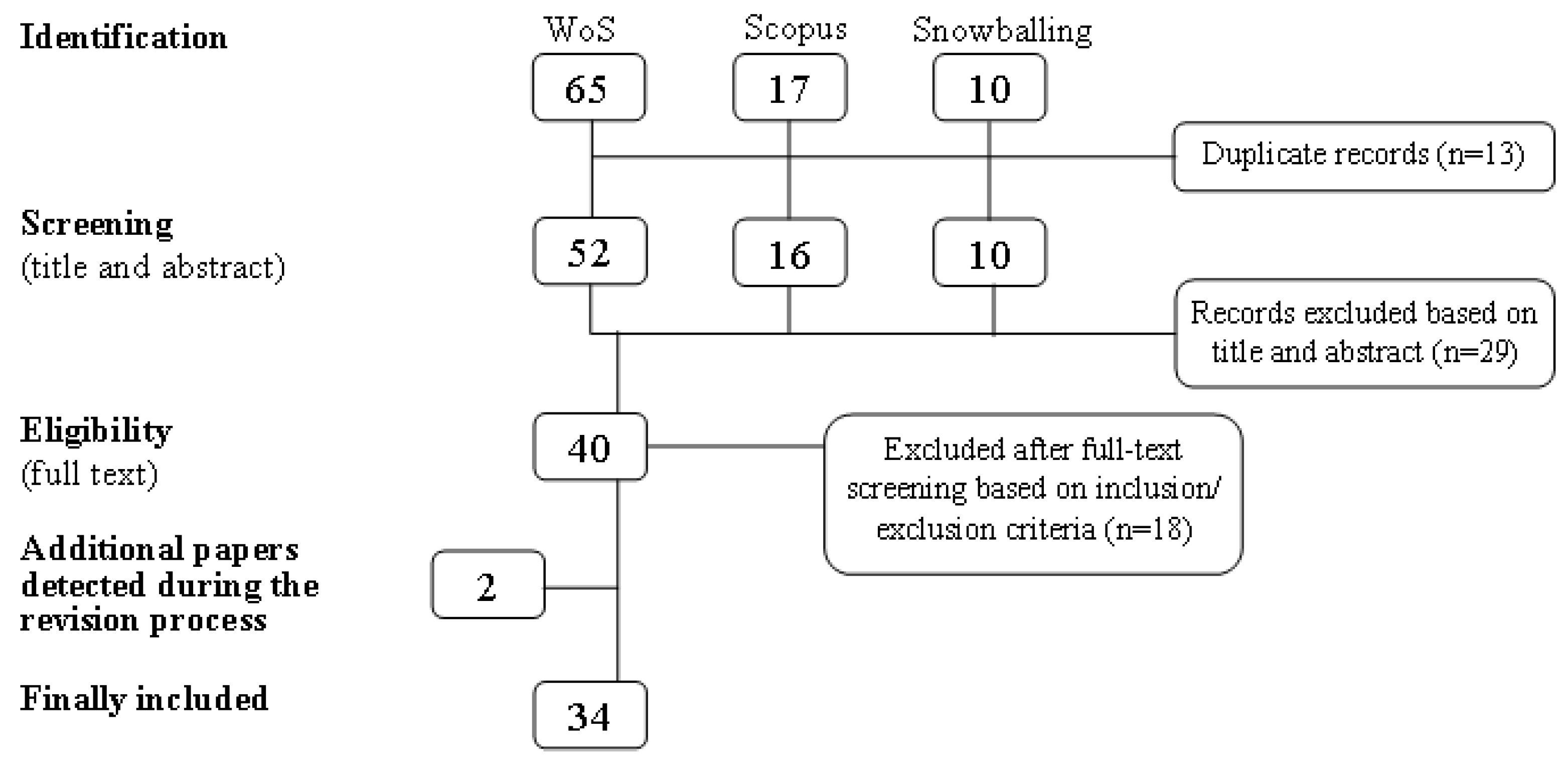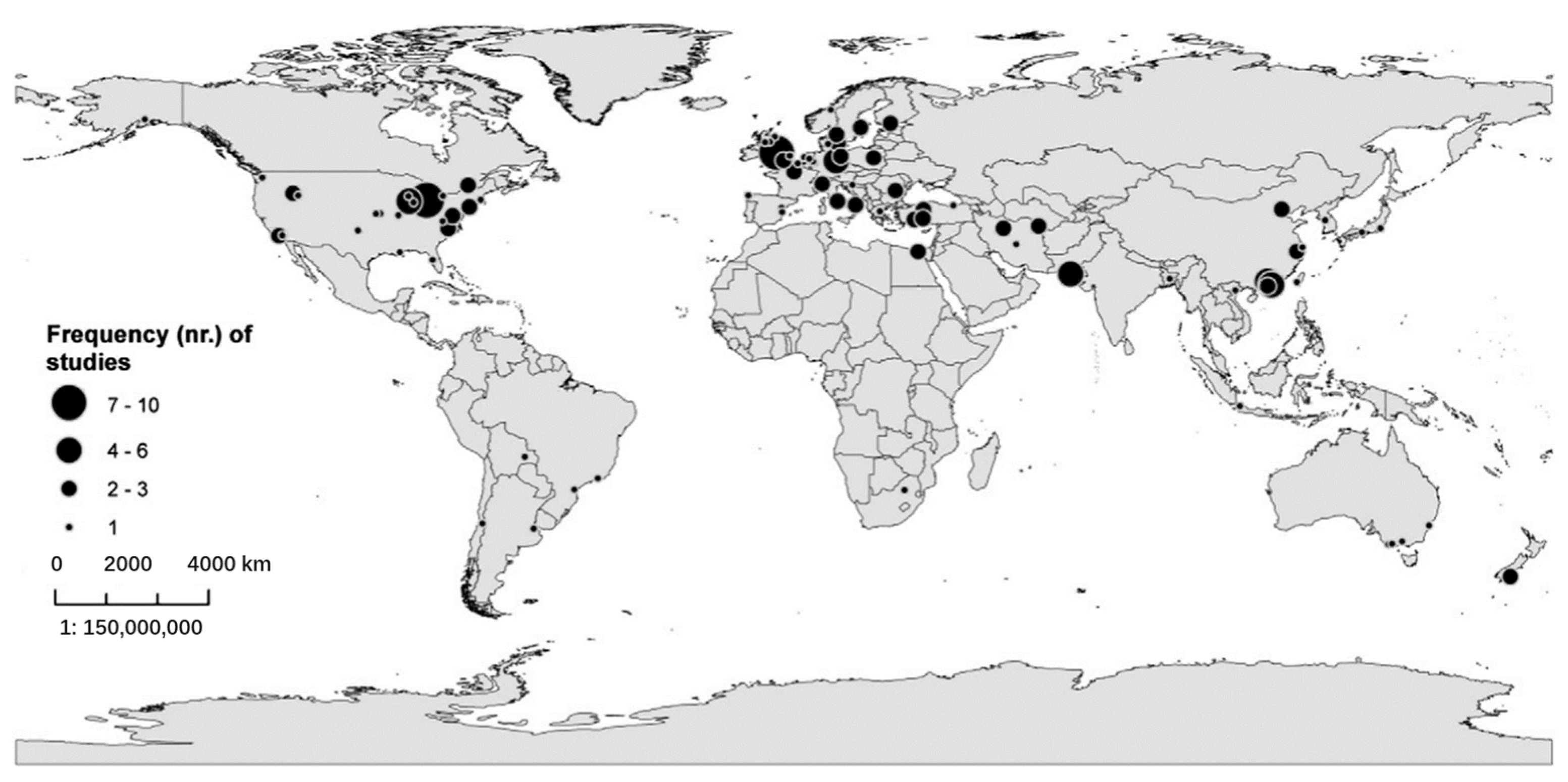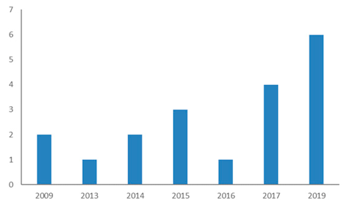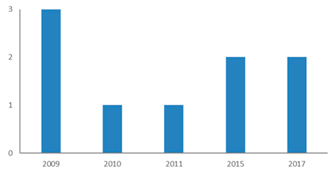Restoration of Visitors through Nature-Based Tourism: A Systematic Review, Conceptual Framework, and Future Research Directions
Abstract
:1. Introduction
2. Materials and Methods
2.1. Systematic Literature Review
2.2. Search Strategy and Selection Criteria
2.3. Study Eligibility Criteria
- The article was an original research article or literature review.
- The article reported data on any measure of restorative experience. The restoration could include psychological health, cognitive rejuvenation, social well-being, or spiritual improvement.
- The article presented evidence suggesting that visitors are directly exposed to the natural environment. The natural environment was used in a broad sense to include any environment that appeared to be green and blue. “Direct exposure” indicated physical presence within the environment and the use of the environment as a setting for tourism activity. Both observational and experimental studies were included. However, experiences based on virtual environments comprising pictures, slides, or videos were not included as participants were not directly exposed to the real natural environment [25].
- The article belonged to the field of tourism, hospitality, or leisure, but not sports.
2.4. Narrative Analysis of the Selected Articles
3. Results
3.1. Overview and General Patterns
3.2. Groups of Publications According to Main Content
- (a)
- Articles that analyzed the direct and indirect restorative effects of nature-based tourism (articles 1–19).
- (b)
- Articles that considered restoration as an important motivation for nature-based tourism destinations (articles 20–28).
- (c)
- Articles that had a conceptual focus and considered scale development (articles 29–32).
- (d)
- Articles that were literature reviews that specifically focused on restoration in the tourism field (articles 33 and 34).
4. Discussion
4.1. Restorative Triggers: Nature-Based Destinations and Visitors
4.2. Restorative Experience and Its Theoretical Explanation
4.3. Potential Restorative Outcomes and Measurments
4.3.1. Physical Health and Psychological Wellness
4.3.2. Spiritual Upliftment
4.3.3. Psychosocial Development
4.3.4. Measures for Restoration through Nature-Based Tourism
4.4. The Effects of Restorative Outcomes on Human–Nature Nexus
4.5. Conceptual Framework of Restoration through Nature
4.6. Challenges in Conceptual Framework
- 5.
- These theories, singularly or in combination, do not conceptualize the full range of restorative experience from nature-based tourism.
- 6.
- They do not fully explicate how nature-based tourism, as a unique concept, supports health and well-being.
- 7.
- Existing frameworks have largely overlooked the inherently multidimensional, interactive, and multisensorial complexity of the relationship between visitors and nature-based tourism.
- 8.
- Additionally, and perhaps most importantly, traditional theories have focused too strongly on the visual form of nature-based tourism by, for example, focusing on what natural destinations look like in terms of color and shape [75].
5. Conclusions
Author Contributions
Funding
Institutional Review Board Statement
Informed Consent Statement
Data Availability Statement
Acknowledgments
Conflicts of Interest
References
- Capaldi, C.A.; Passmore, H.; Nisbet, E.K.; Zelenski, J.M.; Dopko, R.L. Flourishing in nature: A review of the benefits of con-necting with nature and its application as a wellbeing intervention. Int. J. Wellbeing 2015, 5, 1–16. [Google Scholar] [CrossRef]
- Gascon, M.; Triguero-Mas, M.; Martínez, D.; Dadvand, P.; Forns, J.; Plasència, A.; Nieuwenhuijsen, M.J. Mental Health Benefits of long-term exposure to residential green and blue spaces: A systematic review. Int. J. Environ. Res. Public Health 2015, 12, 4354–4379. [Google Scholar] [CrossRef] [Green Version]
- Pitkänen, K.; Lehtimäki, J.; Puhakka, R. How do rural second homes affect human health and well-being? Review of potential impacts. Int. J. Environ. Res. Public Health 2020, 17, 6748. [Google Scholar] [CrossRef]
- Fiorillo, A.; Gorwood, P. The consequences of the COVID-19 pandemic on mental health and implications for clinical practice. Eur. Psychiatry 2020, 63, 1–4. [Google Scholar] [CrossRef] [Green Version]
- Prime, H.; Wade, M.; Browne, D.T. Risk and resilience in family well-being during the COVID-19 pandemic. Am. Psychol. 2020, 75, 631–643. [Google Scholar] [CrossRef] [PubMed]
- Cao, X. COVID-19: Immunopathology and its implications for therapy. Nat. Rev. Immunol. 2020, 20, 269–270. [Google Scholar] [CrossRef] [PubMed] [Green Version]
- Selhub, E.M.; Logan, A.C. Your Brain on Nature: The Science of Nature’s Influence on your Health, Happiness and Vitality; John Wiley & Sons: Hoboken, NJ, USA, 2012; p. 12. [Google Scholar]
- Hartig, T.; Mitchell, R.; De Vries, S.; Frumkin, H. Nature and Health. Annu. Rev. Public Health 2014, 35, 207–228. [Google Scholar] [CrossRef] [PubMed] [Green Version]
- Weiler, B.; Davis, D. An exploratory investigation into the roles of the nature-based tour leader. Tour. Manag. 1993, 14, 91–98. [Google Scholar] [CrossRef]
- Bell, S.L.; Foley, R.; Houghton, F.; Maddrell, A.; Williams, A.M. From therapeutic landscapes to healthy spaces, places and practices: A scoping review. Soc. Sci. Med. 2018, 196, 123–130. [Google Scholar] [CrossRef]
- Gu, X.; Hunt, C.A.; Lengieza, M.L.; Niu, L.; Wu, H.; Wang, Y.; Jia, X. Evaluating residents’ perceptions of nature-based tourism with a factor-cluster approach. Sustainability 2020, 13, 199. [Google Scholar] [CrossRef]
- Lu, N.; Song, C.; Kuronuma, T.; Ikei, H.; Miyazaki, Y.; Takagaki, M. The possibility of sustainable urban horticulture based on nature therapy. Sustainability 2020, 12, 5058. [Google Scholar] [CrossRef]
- Lehto, X.Y.; Lehto, M.R. Vacation as a public health resource: Toward a wellness-centered tourism design approach. J. Hosp. Tour. Res. 2019, 43, 935–960. [Google Scholar] [CrossRef]
- Qiu, M.; Ji, S.; Utomo, S. Listening to forests: Comparing the perceived restorative characteristics of natural soundscapes before and after the COVID-19 Pandemic. Sustainability 2020, 13, 293. [Google Scholar] [CrossRef]
- Wolf, I.D.; Ainsworth, G.B.; Crowley, J. Transformative travel as a sustainable market niche for protected areas: A new de-velopment, marketing and conservation model. J. Sustain. Tour. 2017, 25, 1650–1673. [Google Scholar] [CrossRef] [Green Version]
- Jabareen, Y. Building a conceptual framework: Philosophy, definitions, and procedure. Int. J. Qual. Methods 2009, 8, 49–62. [Google Scholar] [CrossRef]
- Boell, S.K.; Cecez-Kecmanovic, D. On being ‘systematic’in literature reviews. In Formulating Research Methods for Information Systems; Lacity, M., Willcocks, L., Sauer, C., Eds.; Springer: Berlin/Heidelberg, Germany, 2015; pp. 48–78. [Google Scholar]
- Moher, D.; Shamseer, L.; Clarke, M.; Ghersi, D.; Liberati, A.; Petticrew, M.; Shekelle, P.; Stewart, L.A. Preferred reporting items for systematic review and meta-analysis protocols (PRISMA-P) 2015 statement. Syst. Rev. 2015, 4, 1–9. [Google Scholar] [CrossRef] [PubMed] [Green Version]
- Kabisch, N.; Qureshi, S.; Haase, D. Human–environment interactions in urban green spaces—A systematic review of contemporary issues and prospects for future research. Environ. Impact Asses. Rev. 2015, 50, 25–34. [Google Scholar] [CrossRef]
- Kaplan, R.; Kaplan, S. The Experience of Nature: A Psychological Perspective; Cambridge University Press: Cambridge, UK, 1989; pp. 15–27. [Google Scholar]
- McKercher, B. A citation analysis of tourism scholars. Tour. Manag. 2008, 29, 1226–1232. [Google Scholar] [CrossRef]
- Haaland, C.; van Den Bosch, C.K. Challenges and strategies for urban green-space planning in cities undergoing densification: A review. Urban For. Urban Green. 2015, 14, 760–771. [Google Scholar] [CrossRef]
- Keniger, L.E.; Gaston, K.J.; Irvine, K.N.; Fuller, R.A. What are the benefits of interacting with nature? Int. J. Environ. Res. Public Health 2013, 10, 913–935. [Google Scholar] [CrossRef] [Green Version]
- Grinde, B.; Patil, G.G. Biophilia: Does visual contact with nature impact on health and well-being? Int. J. Environ. Res. Public Health 2009, 6, 2332–2343. [Google Scholar] [CrossRef] [Green Version]
- Bowler, D.E.; Buyung-Ali, L.M.; Knight, T.M.; Pullin, A.S. A systematic review of evidence for the added benefits to health of exposure to natural environments. BMC Public Health 2010, 10, 456. [Google Scholar] [CrossRef] [Green Version]
- Rodgers, M.; Sowden, A.; Petticrew, M.; Arai, L.; Roberts, H.; Britten, N.; Popay, J. Testing Methodological guidance on the conduct of narrative synthesis in systematic reviews. Evaluation 2009, 15, 49–73. [Google Scholar] [CrossRef]
- Hartig, T.; Mang, M.; Evans, G.W. Restorative effects of natural environment experiences. Environ. Behav. 1991, 23, 3–26. [Google Scholar] [CrossRef]
- Kaplan, S. The restorative benefits of nature: Toward an integrative framework. J. Environ. Psychol. 1995, 15, 169–182. [Google Scholar] [CrossRef]
- Kaplan, S.; Berman, M.G. Directed attention as a common resource for executive functioning and self-regulation. Perspect. Psychol. Sci. 2010, 5, 43–57. [Google Scholar] [CrossRef] [PubMed]
- Ulrich, R.S. Natural versus urban scenes: Some psychophysiological effects. Environ. Behav. 1981, 13, 523–556. [Google Scholar] [CrossRef]
- Ulrich, R.S.; Simons, R.F.; Losito, B.D.; Fiorito, E.; Miles, M.A.; Zelson, M. Stress recovery during exposure to natural and urban environments. J. Environ. Psychol. 1991, 11, 201–230. [Google Scholar] [CrossRef]
- Kellert, S.R.; Wilson, E.O. The Biophilia Hypothesis; Island Press: Washington, DC, USA, 1993; pp. 103–106. [Google Scholar]
- Lehto, X.; Kirillova, K.; Li, H.; Wu, W. A cross-cultural validation of the perceived destination restorative qualities scale: The Chinese perspective. Asia Pac. J. Tour. Res. 2017, 22, 329–343. [Google Scholar] [CrossRef]
- Chen, G.; Huang, S.; Zhang, D. Understanding Chinese vacationers’ perceived destination restorative qualities: Cross-cultural validation of the perceived destination restorative qualities scale. J. Travel Tour. Mark. 2017, 14, 1–13. [Google Scholar] [CrossRef]
- Seburanga, J.; Kaplin, B.; Gatesire, T.; Zhang, Q.-X. Amenity trees and green space structure in urban settlements of Kigali, Rwanda. Urban For. Urban Green. 2014, 13, 84–93. [Google Scholar] [CrossRef]
- Cripps, K. Chinese Tourism: The good, the Bad and the Backlash. CNN, 15 June 2017. [Google Scholar]
- Yang, Y.; Chen, G. In search of fresher air: The influence of relative air quality on vacationers’ perceptions of destinations’ restorative qualities. Int. J. Tour. Res. 2020. [Google Scholar] [CrossRef]
- Ohly, H.; White, M.P.; Wheeler, B.W.; Bethel, A.; Ukoumunne, O.C.; Nikolaou, V.; Garside, R. Attention Restoration Theory: A systematic review of the attention restoration potential of exposure to natural environments. J. Toxicol. Environ. Health Part B 2016, 19, 305–343. [Google Scholar] [CrossRef] [PubMed] [Green Version]
- Dryglas, D.; Salamaga, M. Applying destination attribute segmentation to health tourists: A case study of Polish spa resorts. J. Travel Tour. Mark. 2016, 34, 503–514. [Google Scholar] [CrossRef]
- Moal-Ulvoas, G. Positive emotions and spirituality in older travelers. Ann. Tour. Res. 2017, 66, 151–158. [Google Scholar] [CrossRef]
- Prebensen, N.; Skallerud, K.; Chen, J.S. Tourist motivation with sun and sand destinations: Satisfaction and the wom-effect. J. Travel Tour. Mark. 2010, 27, 858–873. [Google Scholar] [CrossRef]
- Moscardo, G. Searching for well-being: Exploring change in tourist motivation. Tour. Recreat. Res. 2011, 36, 15–26. [Google Scholar] [CrossRef]
- Mak, A.H.N.; Wong, K.K.F.; Chang, R.C.Y. Health or self-indulgence? The motivations and characteristics of spa-goers. Int. J. Tour. Res. 2008, 11, 185–199. [Google Scholar] [CrossRef]
- Sayili, M.; Akca, H.; Duman, T.; Esengun, K. Psoriasis treatment via doctor fishes as part of health tourism: A case study of Kangal Fish Spring, Turkey. Tour. Manag. 2007, 28, 625–629. [Google Scholar] [CrossRef]
- Chan, C.-S.; Chiu, H.Y.; Marafa, L.M. The Mainland Chinese market for nature tourism in Hong Kong. Tour. Geogr. 2017, 19, 801–822. [Google Scholar] [CrossRef]
- Little, J. Transformational tourism, nature and wellbeing: New perspectives on fitness and the Body. Sociol. Rural. 2012, 52, 257–271. [Google Scholar] [CrossRef]
- McLeod, S. Maslow’s Hierarchy of Needs. Simply Psychology, 29 December 2020. [Google Scholar]
- Laumann, K.; Gärling, T.; Stormark, K.M. Rating scale measures of restorative components of environments. J. Environ. Psychol. 2001, 21, 31–44. [Google Scholar] [CrossRef] [Green Version]
- Hartig, T.; Evans, G.W.; Jamner, L.D.; Davis, D.S.; Gärling, T. Tracking restoration in natural and urban field settings. J. Environ. Psychol. 2003, 23, 109–123. [Google Scholar] [CrossRef]
- Ulrich, R.S. Biophilia, biophobia, and natural landscapes. In The Biophilia Hypothesis; Kellert, S.R., Wilson, E.O., Eds.; Island Press: Washington, DC, USA, 1995. [Google Scholar]
- Newell, P.B. A cross-cultural examination of favorite places. Environ. Behav. 1997, 29, 495–514. [Google Scholar] [CrossRef]
- Kahn, P.H., Jr. Developmental psychology and the biophilia hypothesis: Children’s affiliation with nature. Dev. Rev. 1997, 17, 1–61. [Google Scholar] [CrossRef]
- Dopko, R.L.; Zelenski, J.M.; Nisbet, E.K. Nature salience increases judgments of environmental satisfaction. Ecopsychology 2014, 6, 207–217. [Google Scholar] [CrossRef]
- Purcell, T.; Peron, E.; Berto, R. Why do preferences differ between scene types? Environ. Behav. 2001, 33, 93–106. [Google Scholar] [CrossRef]
- Staats, H.; Kieviet, A.; Hartig, T. Where to recover from attentional fatigue: An expectancy-value analysis of environmental preference. J. Environ. Psychol. 2003, 23, 147–157. [Google Scholar] [CrossRef]
- Ohe, Y.; Ikei, H.; Song, C.; Miyazaki, Y. Evaluating the relaxation effects of emerging forest-therapy tourism: A multidiscipli-nary approach. Tour. Manag. 2017, 62, 322–334. [Google Scholar] [CrossRef]
- Yoo, I.Y.; Lee, T.J.; Lee, C.-K. Effect of health and wellness values on festival visit motivation. Asia Pac. J. Tour. Res. 2013, 20, 152–170. [Google Scholar] [CrossRef]
- Heung, V.C.S.; Kucukusta, D. Wellness tourism in China: Resources, development and marketing. Int. J. Tour. Res. 2013, 15, 346–359. [Google Scholar] [CrossRef]
- Hull, R.B.; Michael, S.E. Nature-based recreation, mood change, and stress restoration. Leis. Sci. 1995, 17, 1–14. [Google Scholar] [CrossRef]
- Reisinger, Y. Connection between travel, tourism and transformation. In Transformational Tourism; Reisigner, Y., Ed.; Cabi: Oxfordshire, UK, 2013. [Google Scholar]
- Kirillova, K.; Lehto, X. Aesthetic and restorative qualities of vacation destinations: How are they related? Tour. Anal. 2016, 21, 513–527. [Google Scholar] [CrossRef]
- Pomfret, G. Personal emotional journeys associated with adventure activities on packaged mountaineering holidays. Tour. Manag. Perspect. 2012, 4, 145–154. [Google Scholar] [CrossRef]
- Puhakka, R.; Pitkänen, K.; Siikamäki, P. The health and well-being impacts of protected areas in Finland. J. Sustain. Tour. 2016, 25, 1830–1847. [Google Scholar] [CrossRef] [Green Version]
- Shin, W.S.; Kwon, H.G.; Hammitt, W.E.; Kim, B.S. Urban forest park use and psychosocial outcomes: A case study in six cities across South Korea. Scand. J. For. Res. 2005, 20, 441–447. [Google Scholar] [CrossRef]
- Home, R.; Hunziker, M.; Bauer, N. Psychosocial outcomes as motivations for visiting nearby urban green spaces. Leis. Sci. 2012, 34, 350–365. [Google Scholar] [CrossRef]
- Lehto, X.Y. Assessing the perceived restorative qualities of vacation destinations. J. Travel Res. 2012, 52, 325–339. [Google Scholar] [CrossRef]
- Han, K.-T. A review of self-report scales on restoration and/or restorativeness in the natural environment. J. Leis. Res. 2018, 49, 151–176. [Google Scholar] [CrossRef]
- Sloan, P.; Legrand, W.; Kinski, S. The restorative power of forests: The tree house hotel phenomena in Germany. In Advances in Hospitality and Leisure; Emerald: West Yorkshire, UK, 2016; pp. 181–189. [Google Scholar]
- Kim, H.; Lee, S.; Uysal, M.; Kim, J.; Ahn, K. Nature-based tourism: Motivation and subjective well-being. J. Travel Tour. Mark. 2015, 32, S76–S96. [Google Scholar] [CrossRef]
- Wearing, S.L.; Foley, C. Understanding the tourist experience of cities. Ann. Tour. Res. 2017, 65, 97–107. [Google Scholar] [CrossRef]
- Kler, B.K. Tourism and restoration. In Philosophical Issues in Tourism; Channel View Publications: Bristol, UK, 2009. [Google Scholar]
- Joye, Y.; Dewitte, S. Nature’s broken path to restoration. A critical look at attention restoration theory. J. Environ. Psychol. 2018, 59, 1–8. [Google Scholar] [CrossRef] [Green Version]
- Franco, L.S.; Shanahan, D.F.; Fuller, R.A. A Review of the Benefits of nature experiences: More than meets the Eye. Int. J. Environ. Res. Public Health 2017, 14, 864. [Google Scholar] [CrossRef] [PubMed] [Green Version]
- Payne, S.R. The production of a Perceived restorativeness soundscape scale. Appl. Acoust. 2013, 74, 255–263. [Google Scholar] [CrossRef]
- Winter, P.L.; Selin, S.; Cerveny, L.; Bricker, K. Outdoor recreation, nature-based tourism, and sustainability. Sustainability 2019, 12, 81. [Google Scholar] [CrossRef] [Green Version]
- Sung, Y.-A.; Kim, K.-W.; Kwon, H.-J. Big Data analysis of Korean travelers’ behavior in the Post-COVID-19 Era. Sustainability 2020, 13, 310. [Google Scholar] [CrossRef]
- Roman, M.; Niedziółka, A.; Krasnodębski, A. respondents’ involvement in tourist activities at the Time of the COVID-19 Pandemic. Sustainability 2020, 12, 9610. [Google Scholar] [CrossRef]
- Kock, F.; Nørfelt, A.; Josiassen, A.; Assaf, A.G.; Tsionas, M.G. Understanding the COVID-19 tourist psyche: The evolutionary tourism paradigm. Ann. Tour. Res. 2020, 85, 103053. [Google Scholar] [CrossRef] [PubMed]
- Richardson, M.; Hamlin, I. Noticing nature, nature connectedness and time in nature: Associations with Human and Nature’s Wellbeing during the Corona Pandemic. PsyArXiv 2021. [Google Scholar] [CrossRef]






| Environmental Terms | Restorative Terms |
|---|---|
| Natur*; park*; green space; blue space; open space; garden*; horticulture*; wild*; countryside; rural; outdoors; biodiversity; wood*; forest* | restorati*; stress recovery; therap*; well-being; wellness; quality of life; health; attention; fatigue; spirit* |
| Group | Case study Countries | Methods | Theory Background | Target Group | Types of Nature-Based Tourism |
|---|---|---|---|---|---|
 Restorative effects | Europe: 7 US: 4 China: 4 Australia: 2 Japan: 1 South America: 1 | Qualitative (interviews, photographs, text analysis, and observation): 3 Quantitative statistics (questionnaire survey, secondary data): 7 Mixed methods: 1 Physiological measures: 2 | Attention restoration theory (ART): 12 Stress recovery theory (SRT): 8 Biophilia hypothesis: 3 | Outside visitors: 29 Local residents: 5 | Forest: 6 Lakes: 3 Mountains: 6 Gardens: 3 Wilderness: 3 Oceans: 2 Beaches: 4 Hot springs: 5 |
 Restorative motivations | China: 4 Australia: 2 Korea: 1 Europe: 1 Turkey: 1 | Qualitative (interviews, observation, and focus group): 2 Quantitative statistics (questionnaire survey, secondary data): 5 Mixed methods: 2 | Maslow’s hierarchy of needs: 4 Push and pull theory: 2 Optimal arousal theory: 1 | ||
 Methodology development | China: 2 US: 1 | Quantitative statistics (PCA, SEM): 2 | Attention restoration theory (ART): 4 Stress recovery theory (SRT): 3 Biophilia hypothesis: 1 | ||
 Literature review | Qualitative analysis: 1 Systematic review: 1 |
| Reference | Motivations | Participants | Destinations |
|---|---|---|---|
| Kerstetter et al. (2004) | (1) Improve physical health (2) Observe the land scale (3) Learn new things about nature (4) Experience tranquility | 450 ecotourists, 18 years of age and older | Gao-Mei, Guan-Du, Ghi-Gu (wetland and hot spring) in Taiwan, China |
| Sayili et al. (2007) | (1) Cure psoriasis | 104 patients with psoriasis | Kangal Fish Spring (hot spring) in Turkey |
| Mak et al. (2009) | (1) Relaxation and relief (2) Health and beauty (3) Get away from the pressures of work and social life | 302 Spa-goers | Spa destination in Hong Kong, China |
| Prebensen et al. (2010) | (1) Getting away from pressure and stress (2) Recovering strength (3) Fitness and health | 1222 outbound visitors from Norway | Sun and sand destinations in Southern Europe |
| Moscardo (2011) | (1) Rest and relax (2) Escape normal routine (3) Physical activity (4) Experience the beauty | 5540 mass visitors organized by travel operations | The Great Barrier Reef (coastal and sea) in Australia |
| Yoo et al. (2015) | (1) Close to nature (2) Relaxation (3) Escape form daily routine | 21 festival visitors | Goomeri Pumpkin Festival (a festival based on a forest in Australia) |
| Kim et al. (2015) | (1) Escape from daily life (2) Pursuing a healthy life (3) Enjoying natural environment | 430 hiking visitors | Olle Trail located on Jeju Island, South Korea |
| Chan et al. (2017) | (1) Enrich travel experience (2) Learn more about nature (3) Share knowledge with others (4) Transform lifestyle | 430 mainland visitors to Hong Kong, China | Nature-based destinations in Hong Kong |
| Dryglas et al. (2017) | (1) Improve physical health (2) Release stress (3) Enhance social contact | 2050 spa visitors | 45 statutory spa resorts in Poland |
| Source | Scales | Constructs | Items | Language |
|---|---|---|---|---|
| Pals et al. (2009) | Perceived Restorative Questionnaire Scale (PRCQ) | 5-factor structure: fascination; novelty; escape; coherence; compatibility | 24 | English |
| Cole and Hall (2010) | Perceived Restorativeness Scale (PRS) | 4-factor structure: being away; extent (coherence); fascination; compatibility; | 20 | English |
| Hipp and Oguseitan (2011) | PRS | 5-factor structure: being away; extent; fascination; compatibility; legibility | 26 | English |
| Woran and Arnberger (2012) | PRS | 4-factor structure: being away; extent; fascination; compatibility | 16 | English |
| Han and Huang (2012) | Restoration Scale (RS) | 4-factor structure: emotional; physiological; cognitive; behaviors | 8 | Chinese |
| Letho (2013) | Perceived Destination Restorative Quality (PDRQ) | 6-factor structure: compatibility; extent; mentally away; physically; discord; fascination | 30 | English |
| Korpela et al. (2014) | Restoration Outcome Scale | 5-factor structure: relaxation and calmness; attention restoration; cleaning one’s thoughts; subjective vitality; self-confidence | 9 | English |
| Letho et al. (2016) | PDRQ | 6-factor structure: compatibility; extent; mentally away; physically; discord; fascination | 30 | Chinese |
| Chen et al. (2017) | PDRQ | 5-factor structure: compatibility; extent; mentally away; physically away; fascination | 26 | Chinese |
Publisher’s Note: MDPI stays neutral with regard to jurisdictional claims in published maps and institutional affiliations. |
© 2021 by the authors. Licensee MDPI, Basel, Switzerland. This article is an open access article distributed under the terms and conditions of the Creative Commons Attribution (CC BY) license (http://creativecommons.org/licenses/by/4.0/).
Share and Cite
Qiu, M.; Sha, J.; Scott, N. Restoration of Visitors through Nature-Based Tourism: A Systematic Review, Conceptual Framework, and Future Research Directions. Int. J. Environ. Res. Public Health 2021, 18, 2299. https://doi.org/10.3390/ijerph18052299
Qiu M, Sha J, Scott N. Restoration of Visitors through Nature-Based Tourism: A Systematic Review, Conceptual Framework, and Future Research Directions. International Journal of Environmental Research and Public Health. 2021; 18(5):2299. https://doi.org/10.3390/ijerph18052299
Chicago/Turabian StyleQiu, Mengyuan, Ji Sha, and Noel Scott. 2021. "Restoration of Visitors through Nature-Based Tourism: A Systematic Review, Conceptual Framework, and Future Research Directions" International Journal of Environmental Research and Public Health 18, no. 5: 2299. https://doi.org/10.3390/ijerph18052299
APA StyleQiu, M., Sha, J., & Scott, N. (2021). Restoration of Visitors through Nature-Based Tourism: A Systematic Review, Conceptual Framework, and Future Research Directions. International Journal of Environmental Research and Public Health, 18(5), 2299. https://doi.org/10.3390/ijerph18052299






